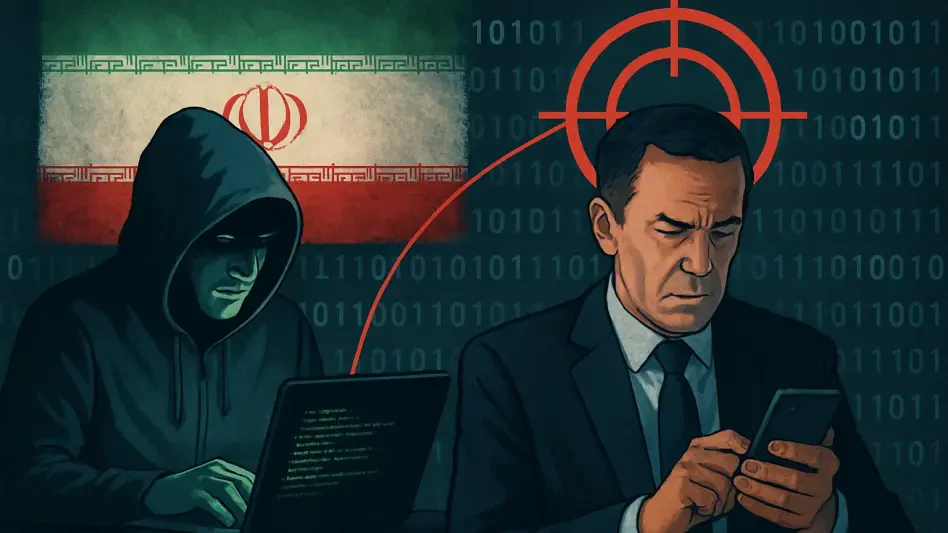What if a single email could unravel the delicate threads of international diplomacy, exposing secure systems to chaos with just one click? Picture a high-ranking diplomat opening an urgent message, seemingly from a trusted foreign ministry, only to unknowingly invite disaster into critical networks. This scenario is not fiction but a chilling reality as Iranian hackers, linked to operations like Homeland Justice, deploy sophisticated spear-phishing campaigns against diplomats across Europe and Africa. The digital battlefield of cyberespionage has never been more perilous, with sensitive communications hanging in the balance.
The Hidden Danger: Why This Matters Now
The stakes of these cyberattacks extend far beyond individual inboxes. Diplomats, entrusted with shaping global alliances and averting conflicts, are prime targets for state-sponsored hackers seeking to exploit geopolitical fault lines, such as the ongoing Israel-Iran tensions. A breach in their communications can destabilize international relations, leak classified strategies, or even ignite misunderstandings between nations. As digital tools become central to diplomacy, the urgency to address these threats grows, making this a critical issue for global security in 2025.
This wave of spear-phishing represents a calculated assault on trust, where attackers craft emails so convincing that even seasoned professionals hesitate before clicking. With over 100 spoofed accounts mimicking legitimate sources, the scale and precision of these operations signal a new era of cyber threats. Understanding the mechanics and motivations behind these attacks is essential to safeguarding the fragile ecosystem of international dialogue.
The Target: Why Diplomats Are Under Siege
Diplomats operate at the intersection of power and secrecy, handling information that can alter the course of history. This unique position makes them irresistible to threat actors, particularly from nations like Iran, where cyber operations often align with broader geopolitical objectives. The potential fallout from a successful attack—leaked negotiations or compromised intelligence—could reshape alliances or escalate existing conflicts, amplifying the allure for attackers.
Beyond the immediate damage, these incidents erode confidence in digital communication, a cornerstone of modern diplomacy. When every email could be a trap, hesitation replaces swift decision-making, slowing critical responses in a fast-paced world. The ripple effects touch not just individual diplomats but entire governments, as trust in secure channels frays under the weight of persistent cyber threats.
The Deception: How Iranian Hackers Strike
The spear-phishing tactics attributed to Iranian threat actors are a study in meticulous trickery. Emails, often disguised as urgent correspondence from entities like foreign ministries, exploit real-world issues to lure recipients. A diplomat might receive a message tied to the Israel-Iran conflict, urging immediate attention, only to find that opening an attached Microsoft Word file unleashes malware designed to siphon sensitive data.
These campaigns rely on impersonation, with attackers using spoofed accounts to mimic trusted contacts or officials. The attention to detail—down to the tone and context of the messages—reveals a deep understanding of diplomatic workflows. Such precision mirrors past operations, like the 2023 cyberattack on dissident groups in Albania, pointing to a consistent and evolving strategy that preys on human vulnerability rather than technical flaws.
Expert Voices: Unraveling the Culprit’s Identity
Cybersecurity firms such as ClearSky and Dream have traced these attacks to Iranian state-sponsored groups with moderate confidence, identifying telltale signs in their methods. A ClearSky analyst remarked, “The way these hackers replicate diplomatic communication shows not just skill but an intimate grasp of their targets’ world—a signature of Iranian cyber operations.” This insight highlights a pattern of behavior seen in other campaigns attributed to the same actors.
Comparative analysis bolsters these findings, as similar tactics surface in unrelated state-sponsored efforts, like North Korea’s ScarCruft attacks on South Korean academics. The shared reliance on social engineering and tailored lures underscores a global trend in cyberespionage, where adversaries adapt faster than defenses can evolve. Staying ahead of such threats demands not just technical solutions but a keen awareness of the enemy’s playbook.
Fighting Back: Arming Diplomats Against Digital Threats
Countering these sophisticated attacks requires a multi-layered approach that blends technology with human vigilance. Diplomatic organizations must prioritize email verification tools to detect subtle anomalies in sender addresses, while staff training should focus on spotting phishing lures tied to current events. Recognizing that a single click can compromise entire systems is the first step toward building a culture of caution.
Beyond individual efforts, robust security protocols like multi-factor authentication and advanced filtering systems can block malicious content before it reaches inboxes. International collaboration also plays a vital role—sharing threat intelligence with allied nations and cybersecurity bodies ensures a collective defense against campaigns like Homeland Justice. These combined measures offer a fighting chance against an enemy that thrives on deception.
Looking back, the battle against Iranian hackers targeting diplomats revealed a sobering truth: the digital realm had become as contested as any physical border. Each spear-phishing attempt was a reminder of the fragility of trust in an interconnected world. Moving forward, the path to security demanded not just stronger firewalls but a global commitment to outsmarting adversaries through shared knowledge and relentless innovation. Only by anticipating the next move could diplomacy reclaim its safe haven in the face of unseen threats.








